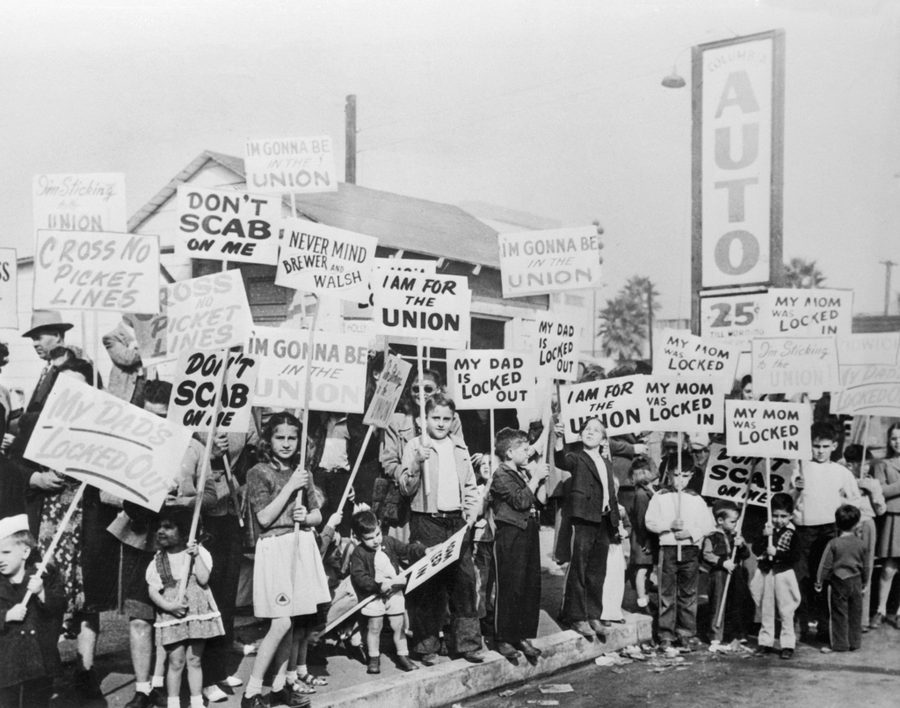Jennifer Abruzzo, the NLRB's General Counsel, Is Labor's Best Legal Friend
In an interview, Abruzzo discusses independent contractors, penalizing bad employers and what she might do to make good faith bargaining a reality in America.
Hamilton Nolan

Joe Biden has pledged to be the most pro-union president in recent memory. Whether that turns out to be true will depend in large part on the work of Jennifer Abruzzo. Since being confirmed as the National Labor Relations Board’s top lawyer two months ago, Abruzzo has wasted no time laying out a strong pro-worker agenda. A memo released in August outlining her priorities indicated her intent to revisit a number of policies in ways that could make them much friendlier to unions and to worker organizing.
Among the most significant are the “Joy Silk” doctrine, which could require employers to demonstrate actual reasons for not voluntarily recognizing unions; Ex-Cell-o Corp, which could impose far more significant penalties on employers for bad faith bargaining; and other items touching on everything from independent contractor classification to the rules for employer handbooks.
Abruzzo, an NLRB veteran who last worked as a lawyer for the Communications Workers of America, is essentially the opposite of her predecessor, Peter Robb--a Trump appointee hostile to organized labor who was fired shortly after Biden took office. We interviewed Abruzzo via email about her priorities, keeping bad employers in line and the flaws inherent in American labor law.
Your intent to revisit the Joy Silk doctrine has gotten a lot of attention. Can you explain your thinking behind that, and what you think the practical effects of a change in that policy might be for unions? You’ve said you also want to revisit Ex-Cello Corp, dealing with potential penalties for employers who refuse to bargain in good faith. Can you explain what you think might result from revisiting it?
Jennifer Abruzzo: When Congress passed the National Labor Relations Act (NLRA), it said in Section One of the Act that it was the policy of the United States to “encourag[e] the practice and procedure of collective bargaining” and to do so “by protecting the exercise by workers of full freedom of association, self-organization, and designation of representatives of their own choosing, for the purpose of negotiating the terms and conditions of their employment or other mutual aid or protection.” To effectuate this policy, there must be meaningful remedies when employers interfere with workers exercising their rights to organize and to bargain.
Both the Joy Silk and Ex-Cell-O doctrines deal with remedies to employer interference in that initial, and often vulnerable moment, when workers first organize a union and request to bargain. Under the Joy Silk doctrine, from 1949 until about 1969, the Board would issue a bargaining order if an employer refused to bargain upon a request for recognition from a union that represents a majority of employees, if that refusal was in bad faith.
The Ex-Cell-O case dealt with monetary remedies when an employer refused to bargain in good faith. In that case, the D.C. Circuit actually told the Board it had the power to order such a remedy and that such a remedy was necessary to effectively remedy the harm. So, I think that both doctrines have support in the Act’s purpose, history, and federal court precedent and are worth reexamining in order to more effectively fulfill the Act’s mission.
There has been a long term trend of companies replacing full-time workers with “independent contractors.” What if anything do you anticipate doing during your tenure that might help give labor protections to independent contractors?
Abruzzo: Whether a worker is an employee or independent contractor is a question of law based on the actual employment relationship — it is not determined by an employer’s label or classification. In the Taft-Hartley amendments to the NLRA, Congress excluded independent contractors from the protections of the National Labor Relations Act. For this reason, whether a worker is an employee versus an independent contractor is crucial. If you are an employee, you have the full protections of the National Labor Relations Act in your workplace, such as the right to organize with your co-workers to improve health and safety, which is a critical right as the country is dealing with a pandemic. If you are an independent contractor, you have none of those legal protections.
In 2019, in a case called Velox Express, the Board majority at that time rejected an argument that employer misclassification of an employee as an independent contractor was itself a violation of the Act. Chairman McFerran (then Member McFerran) wrote a dissent agreeing with the argument. She explained that when a worker is in fact an employee with NLRA rights but is being told by their employer that they are an independent contractor, it sends a clear message to the worker that, in the employer’s view, they have no rights under the Act. She further explained that this communication could unlawfully interfere with the exercise of an employee’s rights.
In my first General Counsel Memorandum, I asked our Regional Offices to submit cases for my consideration as to whether and under what circumstances misclassification itself can violate the National Labor Relations Act, and as to the scope of the independent contractor exemption. With regard to the latter, I believe the statute should be broadly construed and the common law, which delineates a number of factors, provides a very good framework for determining employee status. In the SuperShuttle DFW case, the Board majority at the time put substantial emphasis on the significance of one factor — entrepreneurial opportunity — and that warrants further scrutiny.
Under your existing power, what do you think the NLRB can do to create penalties for employers who violate labor law that are meaningful enough to reverse the current situation in which it makes good economic sense for employers to engage in illegal union busting tactics?
Abruzzo: I will pursue the full breadth of possible remedies under the NLRA to deter violations and to protect and enforce the statutory rights of workers in this country. Full and effective remedies are so important to effectuating the NLRA. It is for that reason that one of my first priorities as General Counsel was to issue GC 21-06 on “Seeking Full Remedies” and GC 21-07 on “Full Remedies in Settlement Agreements,” memos in which I ask our Regional Offices to seek the full panoply of remedies available to ensure that victims of unlawful conduct are made whole for losses suffered as a result of unfair labor practices.
Under the NLRA, the Agency cannot mete out fines or penalties to violators of our statute, but it does have the broad discretionary power to provide make-whole remedies to victims of those violators. A make-whole remedy is one that aims to restore the worker’s situation prior to being subject to the unlawful conduct. For example, if a worker was unlawfully fired, we ask what wages and benefits the worker lost as a result of the firing. But we also need to determine what other economic losses a worker suffered as a result of the unlawful firing. Did they lose their work visa, or their car because they were unable to keep up with their payments? Did they have to move to find another job? Did they need to obtain health insurance coverage or incur medical expenses due to the loss of coverage? Additionally, we must try to discern how the firing affected those in the worker’s workplace, in other words, the chilling effect it had on other workers’ ability to exercise their statutory rights, and how we can most fully remedy those detrimental effects.
So, there is no question in my mind that we can and should do more pursuant to our Congressional mandate under the NLRA as it currently stands.
What is your view on minority or “members only” unions, meaning unions representing less than 50 percent of a workplace? Some believe that employers should be obligated to at least bargain with the members of such a group, even if the entire workplace is not unionized. Is this an issue you anticipate addressing?
Abruzzo: What are sometimes called “members only” or “minority” unions have been present throughout U.S. history. These kinds of formations have often acted as precursors to exclusive majority representatives. The NLRA currently protects the rights of workers to act collectively and engage, through representatives if they so choose, with their employer to improve their working conditions. I encourage engagement between management and labor to ensure that workers’ voices are heard and workers’ concerns are elevated in order to reduce workplace conflict.
As to requiring an employer to bargain or confer with a members only union on behalf of its members, this argument has previously been made by academics and practitioners through various submissions, cases, and a petition for rulemaking. If this issue is brought before me as General Counsel, I would carefully consider it as I do all matters brought to my attention.
Is there any way for workers, unions, and America as a whole to break out of the sort of frantic pendulum of labor rules, as the NLRB swings back and forth between Democratic and Republican administrations? It feels like any gains workers make now will inevitably be rolled back by a future, more conservative board. How does the NLRB make progress that lasts?
Abruzzo: My job as General Counsel of the NLRB is to fully effectuate the Act to the best of my ability, for as long as I have the honor to serve in this role. I am fortunate to have an excellent cadre of dedicated and talented board agents in the field offices and in headquarters to support my efforts to ensure that we are achieving our Congressional mandate to promote industrial stability and collective bargaining and to protect the rights of workers to act together to improve their wages and working conditions.
It is worth noting that the vast majority of meritorious case resolutions occur without any Board intervention (through settlements), thus, the extent of “flip flopping” is minimized. Notably, it makes it that much more important to ensure that the Agency receives adequate budgets so that the Agency has the staffing and resources to educate employees, employers, labor organizations, and community advocates and members, about statutory rights and obligations, to deter violations, and to obtain full remedies during early enforcement to diminish workplace conflict and broader industrial strife.
You’ve worked on the regulatory side of labor, and inside a union. When you think about the barriers to a true revival of union power — how much of that is regulatory, how much is legislative, and how much do you think are missteps of the labor movement itself?
Abruzzo: As an independent federal agency, the NLRB’s role is to vigorously effectuate the NLRA’s mission, which includes protecting workers’ rights to organize and collectively bargain. I have spent the vast majority of my career as a public servant at the NLRB enforcing the Act and so that is what I will speak to. As General Counsel, I can think of no better calling than to ensure that the rights of workers in this country are protected and that violations of these rights are swiftly and fully remedied.
I enjoy good relationships with labor and management practitioners and worker and business advocates, and fully expect to continue to collaborate with them, as well as with Agency personnel, to ensure that we are doing our jobs as effectively and efficiently as possible. This includes having a robust outreach program, particularly reaching those in vulnerable and underserved populations. I certainly think that there needs to be a broader focus on these populations and on workers in general to ensure that more equitable workplace conditions and opportunities are afforded so that they and their families and their communities can not only survive but thrive, particularly during these challenging times.
Hamilton Nolan is a labor writer for In These Times. He has spent the past decade writing about labor and politics for Gawker, Splinter, The Guardian, and elsewhere. More of his work is on Substack.







